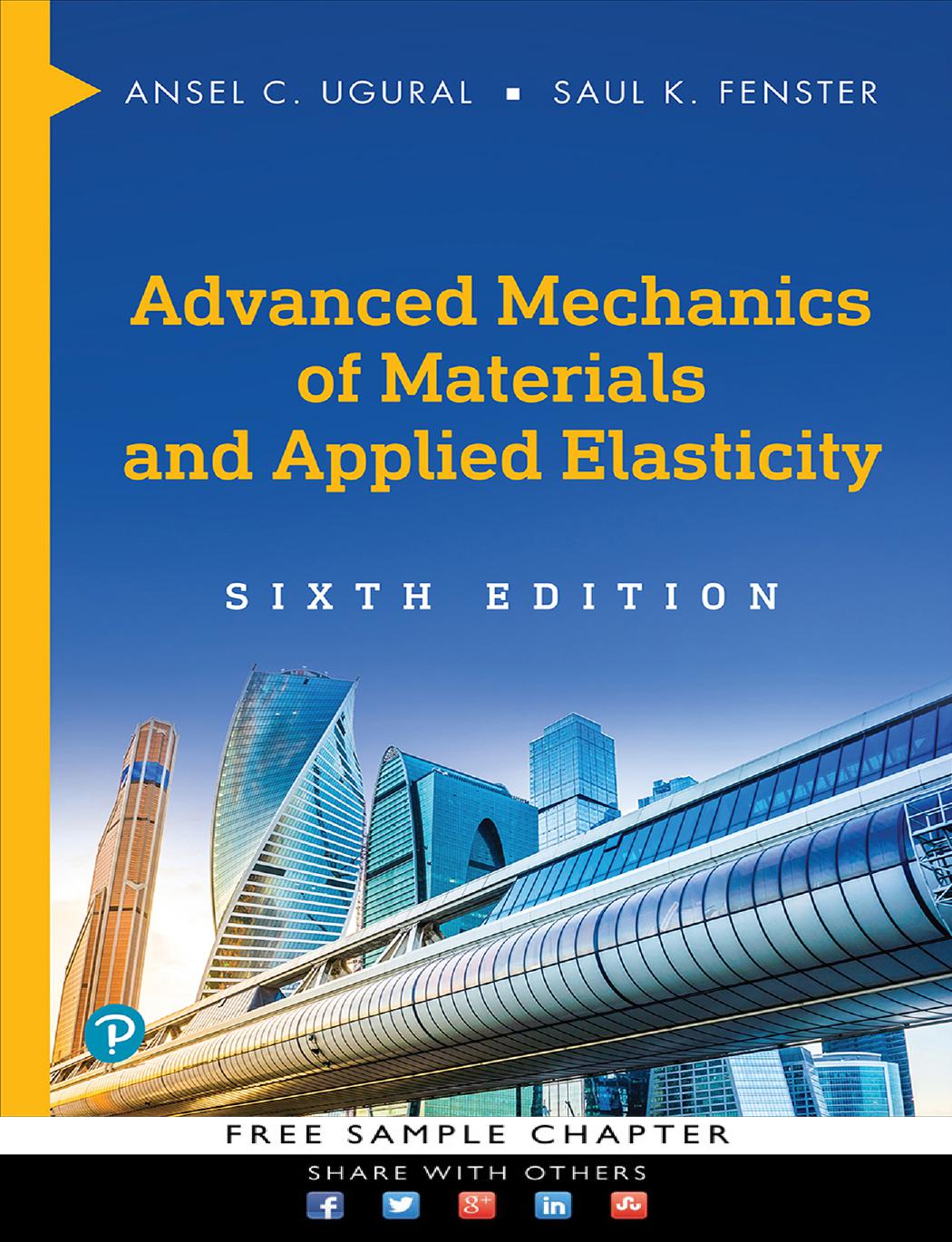INTRODUCTION
Advanced Mechanics of Materials and Applied Elasticity, Sixth Edition, is an outgrowth of classroom notes prepared in connection with advanced undergraduate and first-year graduate courses in the mechanics of solids and elasticity. It is designed to satisfy the requirements of courses subsequent to an elementary treatment of the strength of materials. In addition to its applicability to aeronautical, civil, and mechanical engineering and to engineering mechanics curricula, the text is useful to practicing engineers. Emphasis is given to numerical techniques (which lend themselves to computerization) in the solution of problems resisting analytical treatment. The attention devoted to numerical solutions is not intended to deny the value of classical analysis, which is given a rather full treatment.
Instead, the coverage provided here seeks to fill what we believe to be a void in the world of textbooks.
We have attempted to present a balance between the theory necessary to gain insight into the mechanics, but which can often offer no more than crude approximations to real problems because of simplifications related to geometry and conditions of loading, and numerical solutions, which are so useful in presenting stress analysis in a more realistic setting. This text emphasizes those aspects of theory and application that prepare a student for more advanced study or for professional practice in design and analysis.
The theory of elasticity plays three important roles in the text. First, it provides exact solutions where the configurations of loading and boundary are relatively simple. Second, it provides a check on the limitations of the mechanics of materials approach. Third, it serves as the basis of approximate solutions employing numerical analysis.
To make the text as clear as possible, the fundamentals of the mechanics of materials are addressed as necessary. The physical significance of the solutions and practical applications are also emphasized. In addition, we have made a special effort to illustrate important principles and applications with numerical examples. Consistent with announced national policy, problems are included in the text in which the physical quantities are expressed in the International System of Units (SI). All important quantities are defined in both SI and U.S. Customary System (USCS) of units. A sign convention, consistent with vector mechanics, is employed throughout for loads, internal forces, and stresses. This convention conforms to that used in most classical strength of materials and elasticity texts, as well as to that most often employed in the numerical analysis of complex structures.
ORGANIZATION OF THE TEXT
Because of its extensive subdivision into a variety of topics and use of alternative methods of analysis, this text provides great flexibility for instructors when choosing assignments to cover courses of varying length and content. Most chapters are substantially self-contained, so the order of presentation can be smoothly altered to meet an instructor’s preference. Ideally, Chapters 1 and 2, which address the analysis of basic concepts, should be studied first. The emphasis placed on the treatment of two-dimensional problems in elasticity (Chapter 3) may then differ according to the scope of the course.
This sixth edition of Advanced Mechanics of Materials and Applied Elasticity seeks to preserve the objectives and emphases of the previous editions. Every effort has been made to provide a more complete and current text through the inclusion of new material dealing with the fundamental principles of stress analysis and design: stress concentrations, contact stresses, failure criteria, fracture mechanics, compound cylinders, finite element analysis (FEA), energy and variational methods, buckling of stepped columns, common shell types, case studies in analysis and design, and MATLAB solutions. The entire text has been reexamined, and many improvements have been made throughout by a process of elimination and rearrangement. Some sections have been expanded to improve on previous expositions.
The references (identified in brackets), which are provided as an aid to those students who wish to pursue certain aspects of a subject in further depth, have been updated and listed at the end of each chapter. We have resisted the temptation to increase the material covered except where absolutely necessary. Nevertheless, we have added a number of illustrative examples and problems important in engineering practice and design. Extra care has been taken in the presentation and solution of the sample problems. All the problem sets have been reviewed and checked to ensure both their clarity and their numerical accuracy. Most changes in subject-matter coverage were prompted by the suggestions of faculty familiar with earlier editions.
In this sixth edition, we have maintained the previous editions’ clarity of presentation, simplicity as the subject permits, unpretentious depth, an effort to encourage intuitive understanding, and a shunning of the irrelevant. In this context, as throughout, emphasis is placed on the use of fundamentals to help build students’ understanding and ability to solve the more complex problems.
SUPPLEMENTS
The book is accompanied by a comprehensive instructor’s Solutions Manual. Written and class tested, it features complete solutions to all problems in the text. Answers to selected problems are given at the end of the book. The password-protected Solutions Manual is available for adopters at the Pearson Instructor Resource Center, pearsonhighered.com/irc.
Optional Material is also available from the Pearson Resource Center, pearsonhighered.com/irc. This material includes PowerPoint slides of figures and tables, and solutions using MATLAB for a variety of sample problems of practical importance. The book, however, is independent of any software package.
